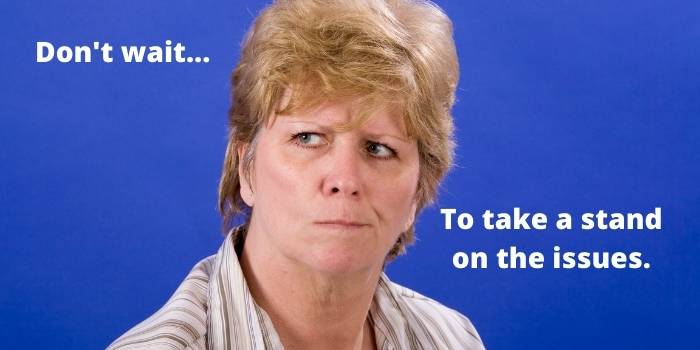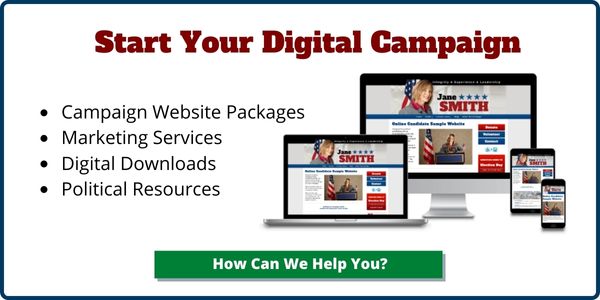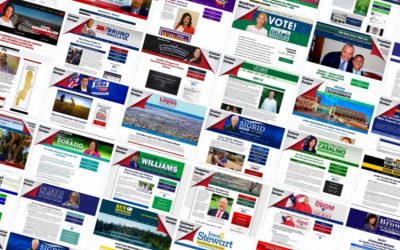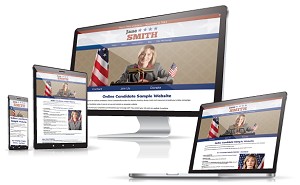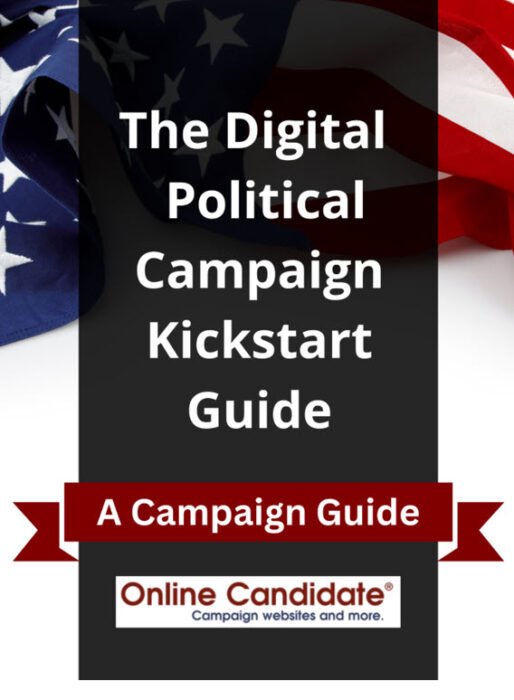6 Website Secrets Your Political Opponent Doesn’t Know
For many first-time candidates, the online campaigning can be an intimidating experience. Technology trends from larger campaigns have trickled down to local races. It’s true that there is a lot more to know today. The bar has been raised as to what the public expects from political candidates online.
If all of this is new to you, relax! You are not alone. Most candidates running for local office do not have a lot of online campaigning experience. We’ve seen candidates with zero experience run defeat a political opponent with a smart online strategy.
On the first campaign we ever worked on, the political opponent was an entrenched incumbent. We were able to promote our candidate’s website and positive news coverage online, while also promoting the negative coverage of our opponent. We were able to attack with impunity, as the opponent had no online presence to start.
Before you worry about creating your campaign website, building out your email list, and what Facebook pages you will create, keep these items in mind:
 Websites don’t win elections: Good candidates and effective campaigns win elections. Campaign websites and social media are ways to communicate with voters, not an end in themselves. Online support only matters if you can translate it into votes. If all your campaigning consists of sending Tweets and posting Facebook updates, then you are going to be in trouble. The web has added to the rules of traditional political campaigning – it hasn’t replaced them.
Websites don’t win elections: Good candidates and effective campaigns win elections. Campaign websites and social media are ways to communicate with voters, not an end in themselves. Online support only matters if you can translate it into votes. If all your campaigning consists of sending Tweets and posting Facebook updates, then you are going to be in trouble. The web has added to the rules of traditional political campaigning – it hasn’t replaced them.- Nobody will find your site automatically: Just putting up a website and expecting visitors automatically is a recipe for failure. Getting people to find your site when they search for you can take a little work. Promote your website in print materials and signage, but also online and through links from other websites. Putting in place a strong SEO strategy will help grow your site traffic.
- Content matters: The only thing more important than having a campaign website is the content within it. Tell voters who you are, where you stand on the issues, how they can volunteer and donate, and how they can help spread the word about your campaign. Use your website as the hub of your online campaign.
- You don’t have to spend a fortune to be online: The cost of a Facebook page and Twitter account is nothing. Building a campaign website can vary in cost, but it’s always sad to hear how a small campaign spent two, three, or even five thousand dollars or more just to get a small site up and running. (Our prices are a lot less, by the way.) Political campaigns are dynamic, and website updates are frequent. If you have to pay an outsider every time you want to make a change to your site, that’s money lost that could go toward other things, like campaign signs, mailings, or fundraising outreach.
- You WILL need to spend money to promote your campaign online: Well, maybe not a fortune. But if you want exposure online, you will need to pay for it. Your online advertising options can include Facebook advertising, pay-per-click ads, and IP targeting. You will want to budget for these advertising expenses as you would for offline advertising.
- Following the rules is a must: Be sure to follow any required website and donation disclaimers, along with other rules, such as what you can and cannot include in your website design. At the very least, breaking rules can become a distraction if your opponent makes a big deal out of a small infraction. In a worst-case scenario, breaking a finance or election rule can get you knocked off the ballot.
Keep an eye on your political opponent
There are a few things that you can do before looking into tracking your political opponents. One important thing is to conduct an analysis using some basic information, such as their name, website URL, social handles, contact details, etc.
Keep an eye on your opponent’s website, social media accounts, press releases and even online donor information. Subscribe to their email list, if they have one. (Do this through a throwaway email account, of course.) Set up tracking through Google Alerts to be notified about online mentions and updates. Track them relentlessly. There are many benefits to just paying attention:
- You will know what the opposing side is saying about you.
- You can get a heads-up on your opponent’s next moves.
- You can find out who is donating.
- You may find an opportunity to attack.
You can be sure the opposition will be doing the same to you.
We wish we could tell you that this is all you need to know to run an effective online campaign, but it isn’t. New candidates should take the time to learn about all the options available in political web design and the digital landscape. Knowing your options will help you prepare a successful digital strategy.
Online Candidate was created to make building your political campaign website as quick and pain-free as possible. We also offer political marketing Services to help set up your online presence.
Announcing Your Candidacy for Political Office
Successful political campaigns start with a big announcement. Of course, there’s a lot more that goes on behind the scenes before a candidate can publicly declare a candidacy. In this article, we will go through the steps and strategies in announcing your political campaign.
A successful campaign launch requires planning and a strong foundation. Here are tips for putting together a plan to announce your candidacy.
A checklist for announcing your political campaign:
- Have your campaign plan in place
- Make sure your brand is developed
- Develop your positions on the issues
- Choose a date to make your announcement
- Prepare your press kit
- Inform your supporters
- Hold the event!
- Make your announcement online
Get our FREE Campaign Kickstart Guide
Get Yours Now.
Have your campaign plan in place
Before you announce your political campaign, you should already have a plan for how you will run your campaign. You will also want a fundraising and spending budget in place for reaching your voter goal.
You campaign team should already be assembled. That will include your Campaign Manager, Treasurer, Volunteer Coordinator, Scheduler, Telephone Supervisor, Social Media Coordinator and Press Secretary. If you are running a local campaign, you may not have all these positions filled yet.
Make sure your brand is developed
The design aspect of your campaign should be set. Branding is a powerful promotional tool that allows a candidate to extend your reach and build trust. A strong brand needs compelling visuals and accurate information and promotion. While your design elements may be the first things voters see, your overall brand should be communicated throughout all aspects of your political marketing and advertising.
Your visual political brand includes:
- Campaign color scheme and fonts
- Political logo design
- Initial candidate photography
Your print or web design should be consistent with the look of your brand. You should build a campaign website and have it in place. It should be made live a few days before you make your announcement.
Develop your positions on the issues
Once you begin your campaign for office, you will be expected to adopt positions on various local issues. You can’t run a campaign while you are still figuring out where you stand on things. This applies whether you are running for school board, city council, mayor, state representative or US Congress.
- What are your positions the major issues?
- What is the most important issue for the candidate?
- Do you know and can compare your opponent’s position on each issue?
- Your messaging and talking points should be in order.
Perhaps most importantly, you should be ready to answer the question, ‘Why are you running for office?‘
Don’t announce without your campaign website in place! Get your professional website created up in days, not weeks.
Choose a date to make your announcement
You will want to choose the right date and time to announce your candidacy. You will want to do it:
- During the week, but not on a Friday.
- On a date that does not clash with a holiday or other major event.
- 10:00 to 11:00AM tends to be the best time to get media coverage for press conferences.
- At a time when you can get the most attendees to your press event.
Where and how will you announce your candidacy?
Try to select a location that holds some meaning for your campaign. The place may be related to your district or to a particular issue. Optics are important. The event will be filmed and photographed, so it should be a place that stands out.
Contact your local media and call a press conference. You want to get as much coverage to your event as possible. Give the outlets enough time to schedule a reporter. Around this time, you may also want to write an op-ed announcing why you’re running.
Prepare an informational press kit
Political press kits are helpful in that basic campaign and candidate information is easily accessible for journalists and interested parties. While you can have this in physical form, a press kit today is much more likely to be digital. It can be added to your campaign website for easy access.
Political press kit items:
- A cover letter describing the candidate and campaign.
- A candidate biography that includes your background, experience, etc.
- Press releases, including one about your entry into the race.
- Digital copies of your campaign logo, brochures, palm cards, flyers, etc.
- Photographs of the candidate and campaign. Offer several versions for download. Low-res files can be used for web. Print requires higher resolution versions.
- Related newspaper or other media excerpts. Rather than reprinting the material outright, you could create a document or PDF file with links.
- A Question and Answer sheet covering the major issues and your campaign platform.
Reach out to your local newspapers and media companies and let them know where they can access your press kit.
Inform your supporters
When you make you public announcement, you will want to let your close supporters, your local party and major local organizations of your announcement. Invite them to attend the event. Even if they are unable to attend, just letting them know ahead of time will make them feel more involved. This can help turn potential supporters into real ones.
You will want to have as many supporters present for the big day. Your campaign staff and volunteers should also be present.
Hold the event!
This is the day! Now is the time you can finally let the world know that you are running for office. You will want to have your stump speech well practiced and ready to deliver. The goal of the event is to create excitement and enthusiasm about your campaign. If you have any major announcements, such as a big endorsement from an organization or prominent politician, be prepared to let everyone know.
There may be media crews present to photograph and video the event. You should still have your own photographer and someone to video the event. That way, you have your own library of media to use for print and online use.
Even if no one from the press shows up, you should still carry on. You can provide a press release and a photo to the media later, along with access to your online media kit.
Make your announcement online
Make sure your website is ready to launch. If you are using social media, have your header graphics and colors set so everything matches your campaign’s overall look and feel.
Tech tip: Make your website live early so the search engines have time to index your pages. It’s a good idea to install Google Analytics ahead of time so your site is indexed faster. Some people may look you up online when they hear of your campaign announcement. You will want your site to be easily found in the search results.
- Check your website grammar and spelling.
- Make sure your website is working properly. Test your volunteer form, contact, and email signup forms.
- Make sure your online donation system is in place and ready to accept contributions from various channels.
- Have your texting and SMS system ready.
- Have your online advertising ready to go.
When everything is ready, post your campaign announcement letter to your Facebook, Twitter and your other social media accounts. Post before, during and after the event. Do a Facebook Live stream during the event. Release a campaign video to your YouTube channel. Start your online advertising, if you are doing so at this time.
Use your campaign launch event as an opportunity to seek help. You need to grow your volunteer base and get more donations to take your candidacy to the next level. This applies if you are running for local, state or federal office.
Once you have launched your political campaign, you will start to get a lot more attention. You will need to be in the public eye more than even. For example, if a local newspaper or radio station wants to interview you, make yourself available. If a group or organization wants to meet with you or have you speak to their membership, don’t turn them down.
Good planning and execution will ensure sure that your entry into politics is off to a strong start. Best of luck!

Ready to begin your online campaign? Online Candidate provides affordable campaign websites and political marketing services to build your digital campaign.
What’s Your Campaign Theme?
For political purposes, your campaign theme covers a variety of elements which are used to communicate a political message. It should be based on a clear reason why a candidate is running for office and backed up by an overall identity that shapes the overall campaign.
The end goal, of course, is to convince people to vote for you.
Listen to this post:
Why are you running for office?
You should be able to summarize your campaign’s main message or narrative into a concise statement that explains why voters should support your campaign, organization or political party. The message should be short enough to not only tell a story, but also to be broken down and used as talking points that can be used by a candidate over and over again.
So, what is a political theme? For your messaging, it’s a summary of why you are seeking office.
For more of an idea, here are some campaign message examples:
- “As we face fiscal woes and a decaying infrastructure, we need leaders who will restore fiscal accountability and help rebuild our state. John Smith is that leader.”
- “Jane Smith is a former teacher and administrator, not a well-connected politician. Her background in education means she can restore accountability to our local schools.”
- “Ian Incumbent has missed over half of the Town Board meetings over the last two years. How can he govern if he doesn’t even do his job? Jane Smith will be there and work hard for the taxpayers.”
- “Our town board is indifferent to citizen needs over outside developers. John Smith will work for sustainable growth.”
- “Colin Candidate is running for judge to insure impartial and fair justice for all.”
All these examples touch on an important issue to voters and what the candidate is going to do when elected. From the examples above, you can extract the major theme in just a few words. As you refine this, it will become your elevator speech and the basis for your candidate stump speech.
Your messaging should reflect and promote that idea throughout the campaign. In one form or another, your message should be repeated at every opportunity, in every available medium.
Why are you seeking elected office? The answer is what you hope to accomplish when you win.
[bctt tweet=”Your campaign’s main message should be a concise statement that explains why #voters should support you.”]
Your campaign theme should appeal to voter emotions
If your theme can play on voter emotions, it can become far more powerful. What are the wants and needs of your community? Education? Jobs? The economy?
- Know the issues and interests of your target voter. You can find this out through public meetings, newspapers and just speaking with people. Learn how your solutions contrast with those of your opponent.
- Show you can relate to and feel your target voter’s pain. Political themes that can tie both a problem and a proposed solution together is a powerful message.
- Most people vote on emotion, not logic. Tap into and create a memorable emotion that gives voters feelings about you and what you hope to accomplish.
It’s emotion that makes political ads so powerful. In a 2005 American Journal of Political Science study, it was found that emotional reactions occur faster than conscious appraisals. This is why negative political advertising is so persuasive – because it works. This isn’t to say that your campaign should be based on negatives, but perhaps how you couch your issues can influence voter’s emotional reaction and participation.
All of your campaign communication – speeches, print material, signage – should reinforce your theme and the feelings they produce. Your campaign message should show that you share a voter’s values. This helps them identify with you and builds trust.
Your campaign slogan – an extension of you
While a summary of your campaign is great and should be practiced until it can be recited in your sleep, the average voter needs something even shorter. They need a slogan that encapsulates the idea of your campaign.
Your slogan should touch on the major issue or reason for your campaign. Examples of this includes:
- Let’s Make a Difference
- A Voice for Smart Growth
- Proven Leadership.
- Quality in Government
- Fair and Impartial Justice
Your campaign slogan should be related to your message. For example, if you are running an anti-sprawl campaign, a slogan like ‘A Voice for Smart Growth‘ would be appropriate. It’s short, it fits on a campaign sign (if it had to) and is related to a major campaign issue.
[bctt tweet=”Your #political campaign slogan should encapsulate your entire campaign. http://ow.ly/McUq30gBjnT”]
What’s your color theme?
It’s usually best to keep your campaign color scheme to two colors, one lighter and one darker. Simple is best. That goes for your fonts, as well. A nice sans-serif font is better than a fancy script font. Most political organizations tend to use sans-serif fonts for their boldness and readability.
What colors are you going to use to promote your campaign? In the US, red, white and blue are always favorites, but if you were running on environmental issues, perhaps green and white might be a better scheme.
There is a bit of science behind color and how it makes people feel.
- Red often indicates excitement or danger. This color corresponds to the Republican party.
- Blue indicates peace and tranquility. This color corresponds to the Democratic party.
- Green indicates life and growth. This color is used by, yes, the Green Party and often by independent candidates.
- Orange is often interpreted for innovation and creativity.
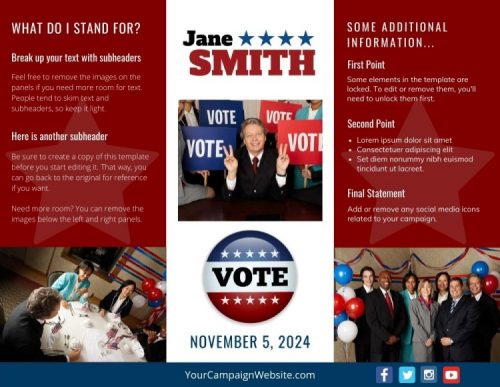
All of your print materials should match your color scheme.
Whatever you do, once you commit to a color theme and slogan, stick with them. Switching things up halfway through election season will only dilute your brand and confuse voters.
What about your website?
Your online presence – your political campaign website, social media profiles and online advertising – should all match in look and feel. You will want to use the right tools to build your website. A good design should have colors and fonts that match your offline signage. The look of your site should tie together the position you are running for or the major issue behind your election.
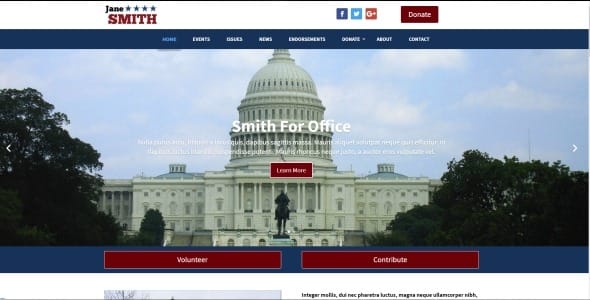
The colors of your website design should match your print and sign material.
Hammer that campaign theme home to voters
At this point, your political campaign theme is well on its way. You have a message, a slogan, and a general design scheme. From here on in, it’s a matter of combining and using these elements consistently though your campaign literature, TV and radio ads, signage and your campaign website. Hammer that messaging home so every voter can easily recall what you stand for, and why they should vote for you on Election Day.
Our online store carries Campaign Letter Templates, and Campaign Brochure Templates – or save with a Digital Combo Package.
A Sample of Our Best Political Website Designs
Wondering what we think of our own work? In this post, we’ll show you some of our best political web designs.
Normally, these types of posts about the ‘best campaign sites of the year’ are where design firms show off which websites they think were best in the last election cycle. In these posts, you’ll see the same designs over and over again for various presidential, congressional and state legislative candidates.
Except those sites weren’t even created by those who are ranking them. What gives?
This is something a little different. These sites are all custom designs by Online Candidate (actually, Carol). These political website design examples are either a Custom Design Package or a custom design upgrade to our template-based packages.
So, here we go:
Alderman Website
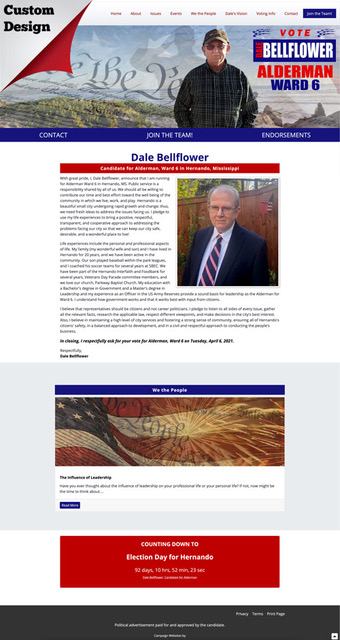
Client had submitted his logo and several photos of himself. In his design questionnaire he mentioned wanting to have an outdoor feel – but he was also retired military, so a patriotic feel was also important.
I really liked the photo of him on the beach. It was a really nice shot and encompassed the outdoors feel he was looking for. I took the photo and removed the background. I added a stock photo of the US flag and constitution and a took a silhouette stock photo of a military solider saluting. I made both of those partially transparent, so they give a subtle patriotic feel without overpowering the image.
I really love how this banner came out. The client provided a great photo, and with his basic direction I was able to create something that fit the visual impression he wanted to convey.
The client was very happy and requested the artwork for use in his campaign.
Board of Education Website
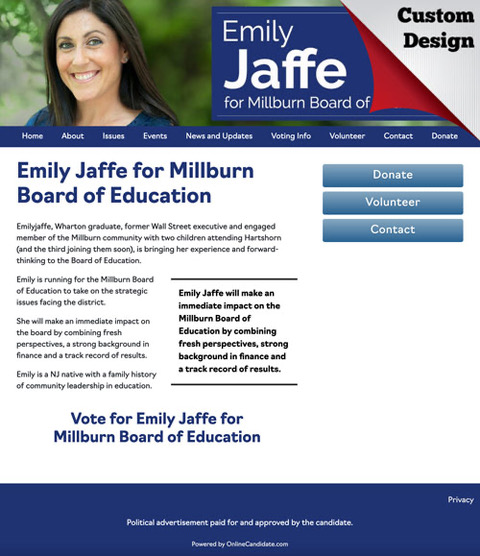
This header design is a favorite in our design gallery and is one of the most requested designs by clients. Though the design trend today is to have a small logo with a ‘hero’ shot below, a lot of candidates still prefer a more graphical image header. One advantage to a header incorporating a head shot image is that it carries through all the pages.
The client wanted to have an outdoor feel. She specifically took an outdoor photo for the site, but all the photos she sent were vertical shots. Unfortunately, vertical images do not work on full-width horizontal headers.
To make this image work, I removed (cropped) the background from the right side. Then I found a stock photo of trees to use as the background. I blurred the background and then merged the background and head shot together. Between the sharp head shot and blurred background, I really like this look.
City Council Site
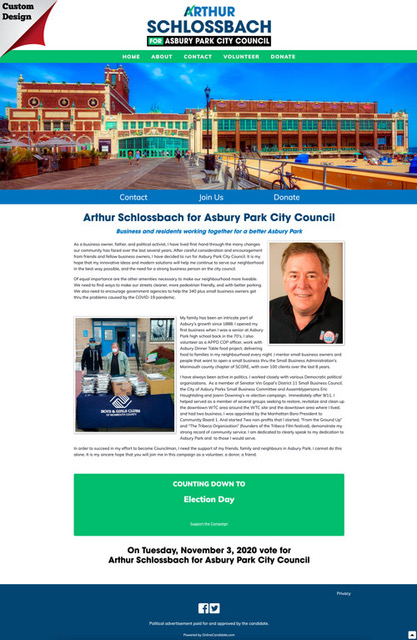
This is another full-width favorite. I was pleased with how it came out, especially since the candidate did not have any idea of what he wanted other than the basic colors. I created the logo and found stock art of a well-known location in the election district. This particular photo worked perfectly with his color scheme.
As I do for all my clients, I saved the logo in various formats for use in his campaign brochures and signage.
Judicial Candidate Website
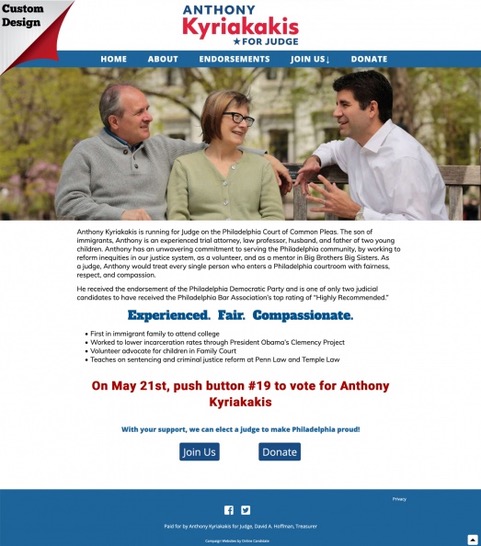
This site was one of the first to feature a full-width photo and the image worked perfectly into the layout. His photo is interesting and really engages with the visitor. Normally, judicial candidate sites tend to have a color scheme of black and yellow or black and white. However, less stark colors better match the informal nature of the picture.
State Representative Website
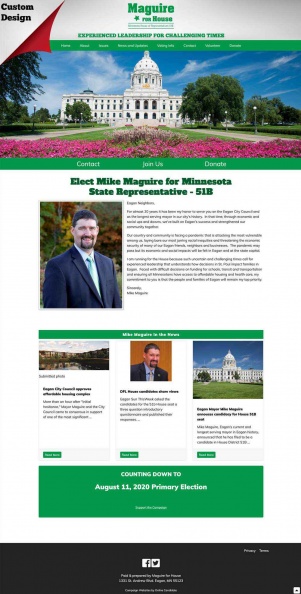
This is another case where I was able to find a really nice stock photo of the state house to use in the design. Sometimes the free stock image sites will have perfect photo. Other times, clients will submit a photo of their area. For a wide top or slider image it’s best to have the photo be horizontal and a more panoramic shot. Or at least have dead space in the top and bottom that will be cropped.
Solicitor General
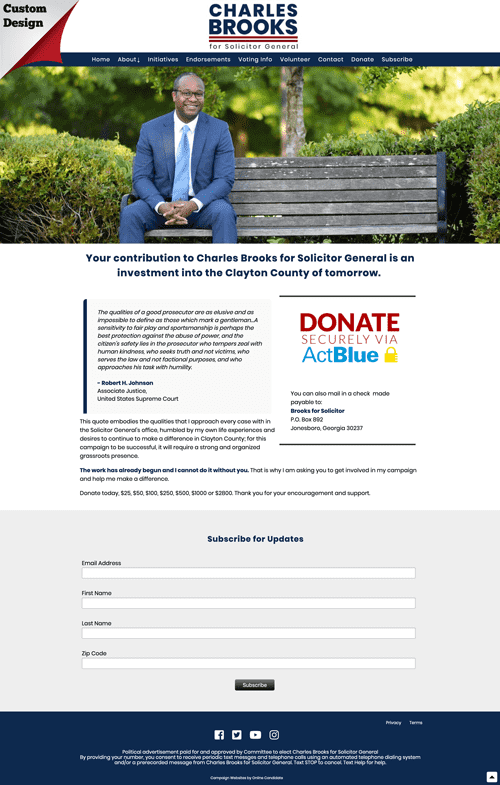
This candidate website is another favorite of mine. The client submitted several great photos and wanted a blue with red accent color scheme. I created the logo and sent it to him in various formats for use elsewhere. I really love the photo of the client on the bench. The composition is great. It creates a nice interesting, yet personal feel.
Not all Online Candidate websites are custom-designed. Many clients use our template features to create their own look. They can choose (and customize) a color scheme, fonts, header layout and more. Those candidates using social media can display automatic updates from their Facebook and Twitter accounts. Some clients with a bit of web design knowledge push things even further. We’ve had clients who never built a website before use our system and really put together sharp-looking sites.
What element makes a design look best?
You know what really makes a site design look great? The photography. A campaign’s visuals need to be compelling and help tell a story to voters. Having a good stock of images when we begin a project makes it easier to create a design that really stands out. Good lighting is also important. A mobile device can take a great shot, but only if there is good lighting. Bad lighting will ruin the best composed photo.
In the early days, we would sometimes have to scan in a client’s photographs. This was back in the 2000s, the days of flip-phones, before everyone carried a good camera and video recorder right in their pocket.
- Color makes a big difference in a candidate’s brand. Sometimes we will alter the colors a bit for the web if a candidate already has print brochures or signage. A traditional ‘red, white and blue’ color scheme might not translate well to a website. Sometimes we will tone things down a bit and include complementary colors to make the site look best.
- These days, many candidates start with a website first and we come up with the campaign’s final color scheme and logo design. Once that’s set up for the website and social media accounts, we will provide original art files back to the candidate upon request for use in their print materials and signs. That way everything has a consistent look, making things more identifiable to voters.
- Website copy is another important aspect of design. People tend to skim when reading online, so headlines, bulleted lists and bold text help provide important information quickly. Having a call to action on every page is important. When we set up a site for a client, we make sure that it’s not only optimized for search engines, but also optimized to get visitors to take action.
Related: Download our Online Candidate Quickstart Guide
Ready to start your own campaign site?
Our job is to help local candidates create a winning online campaign through our political web design and digital marketing services. We have a variety of package prices and even a monthly option for $29/month. You can set up and design your own site or we can do it for you. Either way, you control your site and can update it whenever you choose.
We also offer a variety of add-on options, including social media account setup and candidate intro videos to help launch your online campaign quickly and easily.
Related: Political Website Design
Political Print Template Design Services
Find out which services are best for you. Have a question? Contact us for more information.
Raising Seed Money For Your Political Campaign
One of the largest obstacles that political campaigns face is raising initial funds for the race. Starting a campaign without money is difficult, and raising money often requires spending money upfront. Mailers cost money. Holding in-person events or rallies require some up-front costs. Many local candidates simply don’t have a lot of funds to put up themselves.

If you have rich relatives or friends who are willing to help you launch, that’s great. For those who have it a little tougher, the web offers powerful opportunities to raise seed money donations for political candidates and non-profit organizations.
The two elements to raising seed money donations
As more money is spent on politics, even local elections are becoming increasingly expensive. Even a great candidate running on a strong platform is not enough.
To raise money, you need both exposure and a mechanism.
Mechanism
The mechanism is the way through which you process donations online, starting with your campaign bank account and a reliable fundraising platform. While some candidates use PayPal, politically oriented services like ActBlue, WinRed, or Anedot are often better options. These platforms are designed specifically for political campaigns and offer features like social sharing, e-ticket sales for events, and compliance with reporting requirements.
For example, ActBlue is popular with Democratic candidates, while WinRed caters to Republican campaigns. Anedot works for both parties and is great for local campaigns that need flexible solutions. Researching and choosing a platform that aligns with your needs is critical for smooth and transparent fundraising.
Exposure
Who is going to give you money if they don’t know about you or your campaign? That’s where exposure is needed. Building awareness is key, and creating buzz before you officially announce your campaign can give you a major advantage. If you are able to secure startup funds before your announcement, it will give you a leg up right from the start.
Even if you can’t accept or spend money early, you can still do things to create anticipation. Use tools like social media and email marketing to build excitement and get supporters ready to donate once your campaign officially launches.
How to reach out to potential donors
Social media is a great way to build a following online and get your message out early. Experts recommend starting an online presence as early as possible to build a network of friends and supporters. Facebook and X / Twitter are still the largest platforms for political campaigns, but newer platforms like Instagram and TikTok can also be highly effective, especially for engaging younger voters.
- Facebook: Create a campaign page and use Facebook Events to promote fundraisers. Consider running targeted ads to reach potential donors.
- X / Twitter: Use hashtags and engage in trending conversations related to your platform.
- Instagram and TikTok: Share short videos introducing yourself, explaining your campaign, or thanking donors for their support.
A website lends credibility and creates a hub for your online campaigning. Many people will not donate through a Facebook post or an X/ Twitter link (though more do so today than a few years back). A campaign website provides a fixed place where voters and donors can visit for updates, news and information. It is the place to send donors from outside locations so they can learn more about the campaign and donate.
During time you should also be building your email list. The sooner one is started, the more time you have to build subscribers that you can reach out to repeatedly throughout the campaign. Your own email list will always be more valuable than rented lists. State and congressional candidate treat their lists like gold – and so should you.
Building Anticipation
Having a good online presence, even a small one to start, tells donors that you are serious about running for office and serious about winning the election. For example, share behind-the-scenes updates, ask for feedback on campaign themes, or conduct informal polls to engage supporters early on. For example, a school board candidate could build anticipation by sharing a countdown to their campaign announcement alongside inspirational quotes and community snapshots, driving interest and followers ahead of launch.
Make a compelling case why they should support you, and you should be well on your way to taking that seed money and growing it into something much, much larger!
Online Candidate’s campaign website packages are affordable for any campaign. We also offer a variety of popular political ebooks, including our own guide, Running for Office as an Online Candidate.
Related:
How Candidates Raise Money For Local Campaigns
Download the free Online Fundraising Guide
Facebook Political Ad Authorization – What You Need To Know
A number of clients and outside candidates have reached out to us because they’ve had problems getting authorized to run political ads on Facebook.
If you don’t know already, Facebook requires verification from you or a member of your campaign if you want to run political advertising through the platform. The verification process was put in place to stop the spread of misinformation on the social network. It was also in response to the Cambridge Analytica scandal, where the company harvested the profiles of 50 million Facebook users without their consent to build voter-targeting models.
Facebook is not just a social media platform; it is also an advertising platform. Being authorized means that other people will be able to see your ads and your ad budget for this account.
Even if you are just running a page for your political campaign and do not plan on running any promotions, it’s a good idea to verify yourself and become authorized.

In 2018, Facebook launched an authorization process for political advertisers to run “electoral or issue-based” ads.
What constitutes political advertising on Facebook?
Political advertising includes ads about social issues, elections or politics. Advertising includes targeted image or video ads, Facebook Live event promotions – or even just boosting a post that contains political content.
The criteria for political advertisers include ads that are:
- Made by, on behalf of, or about a candidate for public office, a political figure, a political party or advocates for the outcome of a public election
- About any election, referendum, or ballot initiative. This includes “go out and vote” ads
- About social issues in the location where ad is being placed
- Regulated as political advertising
Social issues is a pretty broad term. Facebook lists the topics that count for advertising purposes. In the United States, they include:
-
civil and social rights
-
crime
-
economy
-
education
-
environmental politics
-
guns
-
health
-
immigration
-
political values and governance
-
security and foreign policy
Facebook verification for political ads begin in May of 2018. It required a label on political advertisements to let users know that an ad contains political content.
If you are going to run an ad on Facebook that focuses on any topics on this list, it must also contain a disclaimer.
All political ad disclaimers must:
- Accurately represent who is responsible for the ad and include accurate, valid information.
- Not include profanity, objectionable language or unrecognizable words or phrases.
- Not include URLS or acronyms, unless URLs or acronyms make up the name of the organization.
- Not imply that your ads are associated with Facebook.
- Not imply that a foreign leader paid for the ad.
- Not include duplicate “Paid for” language that is the same as provided by Facebook.
Facebook must approve your disclosure against their own advertising policies before your ad can run.
If an ad runs without a proper disclaimer, it will be paused, disapproved and added to the Ad Library, until the advertiser completes the authorization process and is approved.
Starting the Facebook ad authorization process
Make sure you have the following information ready before you begin. This will save you a lot of time and frustration as you confirm your identity.
- You must be the Page administrator or advertiser on the Page from which you’re running ads about social issues, elections or politics.
- A US passport, driver’s license or ID card.
- A US-based residential mailing address.
We’ve found this Facebook Help article to be helpful for those who want to start the verification process.
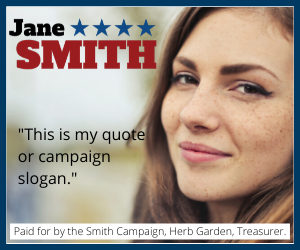
Ads on Facebook, Google and other ad networks today require a ‘paid for’ disclaimer.
The Facebook political ads verification process:
- First, you’ll need to set up two-factor authentication. This is a security feature that helps protect your account from hacks.
- Provide a copy of at least one US-based, government-issued ID. This can be a driver’s license or passport. Make sure the image is clear and readable.
- Provide the last four digits of your SSN.
- Provide your mailing address. This is where Facebook will send the verification code.
- Once you request a verification card, it will take (roughly) a few weeks until receive a card in the mail. This will contain a code for you to enter to confirm your identity.
- Enter the card code provided to confirm your address verification (you can do so by returning to facebook.com/id/us_political_ads_advertiser/
The steps of this process are similar if you want to verify a location for a listing or business page.
- You will need to provide details regarding the funding of the political advertising. You’ll have to disclose whether the funds paying for the ad come from a political party or if they are self-funded.
- Once your identity and information is verified and you have been allowed to run political ads, you will need to link your ad accounts in Business Manager to set up your “paid for by…” disclaimers.
- After submitting your disclaimers and linking that will be allowed to post ads, you will not be able to place new ads from the ad account until your disclaimer has been approved. This process can take a day or so.
- Once approved, you’ll see a new option appear in the ad creation process. If your ads include political content, you’ll need to check the box to add a “paid for” disclaimer.
How long does it take your account verified and approved?
According to Facebook, if you follow these steps properly, you should expect to receive your verification card in 7–10 days. We have had clients that received their cards within that time. Others did not get their cards for a few weeks. And we also heard from several angry candidates that they never received anything at all!
Do NOT try to run political ads before you are authorized
Most ad rejections seem to be automated. If your campaign page has already been determined to be political in nature, any campaign advertisements run through that page will be automatically flagged for review.
If you want to run election ads through Facebook, you need to be authorized and FIRST.
If you repeatedly try to push ads through before you are properly verified, it’s possible you may have your ability to run ads permanently disabled. We don’t know this for a fact, but feedback from some of our clients suggests this might be happening. So, be careful.
Banned election advertising?
Both Facebook and Google instituted issue-advocacy and political ad bans in the weeks leading up to the US 2020 general election. This was done in an effort to curb misinformation on behalf of politicians and special interest groups. While Google soon lifted its ban after the November election, Facebook prohibited political ads on its social network indefinitely.
Facebook eventually lifted its self-imposed prohibition in March, 2021. Could this political advertising ban happen again? It’s certainly possible, and campaigns should prepare for that eventuality.
Unfortunately, we CANNOT help with Facebook ad authorization. We wish we could. As it is, we have no special tricks or connections to help with what can be a very frustrating process…
Good luck!

Related:
- Facebook for Political Campaigns
- Using Facebook Live for Your Political Campaign
- Why Running Your Campaign From Just Your Facebook Page Is A Bad Idea
This post was updated on January, 2022




